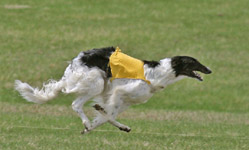
Conformation and Speed in Borzoi

I) Purpose of the Study
:a) To determine the aspects of Borzoi conformation that affect speed at a gallop.
b) To examine the relation between various aspects of conformation and speed.
Why focus on speed?
Speed is the most critical feature of borzoi type and function, and it can be measured. It is more difficult to measure agility, desire and power. It is important to remember that this study examines only the relation between the various characteristics of conformation and speed.
Importance of the study:
Many other breeds have developed into a show-type that competes in conformation, and a field-type that competes in performance events. It would be a tragedy to have this happen to borzoi. At this time we have borzoi who excel in both conformation and coursing/racing events. What is written in the AKC, Russian and FCI standards that describes the features of a borzoi including those that are critical to speed. This study is to try to determine which conformational factors most influence speed. Hopefully, then applying this information to keeping our breed functional.
This study seeks to identify those characteristics of Borzoi conformation that enhance speed and those characteristics that detract from it.
Examples of breeds with separate types for function and show:
From the AKC Labrador Retriever standard:
"The head should be clean cut and free of fleshy cheeks."
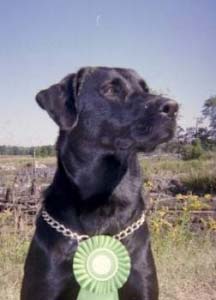
Field Labrador
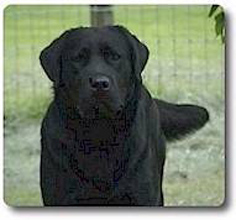
From the American Cocker Spaniel standard:
"Excessive Coat and feathering shall be penalized."
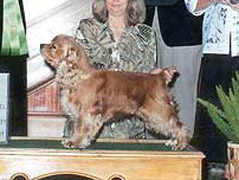
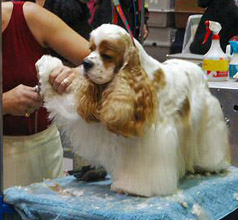
Show Cocker
Apparently then, the problem is not as much with the standards, but with fanciers interpreting incorrectly (or ignoring) the standards.
II) Conformation Characteristics:
Focusing on those cited in Borzoi standards; characteristics were selected that differentiate sighthound anatomy from that of other breeds of dog.
Sighthound features listed in Borzoi standards:
elegance /refinement*** important, but not measurable
1) long legs
2) bladed bone
3) deep & narrow chest
4) high tuck up
5) wide rear
6) short back & ribs/ long loin
7) high ear set
8) tight elastic skin
9) angled croup
10) broad loin
-Measurable features mentioned in Russian, FCI and AKC standards that are not listed above and may or may not correlate to speed:
11) angle of hock (rear angulation)
12) length of stride
III) Data Selection & Description of the test
72 Borzoi from over 20 different kennels – many of which participate in both performance and conformation events*.
All Borzoi used in my study meet the following conditions:
a) The Borzoi follow the lure/squawker with enthusiasm. Borzoi that did not appear to be running with maximum effort were removed from the study. The squawker is run in a straight line.
b) Only healthy, fit Borzoi between the ages of 2 and 6, inclusive are measured.
c) Borzoi are selected by owners for participation in study*
* These factors bias the sample toward faster than average Borzoi
taken from floor to point of elbowSpeed is measured from behind the dog at approximately 75 - 150 yards from the start with a Bushnell Speedster radar gun designed for baseballs.
Physical characteristics were measured with calipers, measuring tape or compass as indicated. The measurements taken are as follows:
Height at withers (cm)_______
Height at elbow (cm) _______-
Width of chest (in) _________-
taken at widest pointDepth of chest (in) _________ -
taken at level of T 11Width of loin (in) _________-
taken at level of L5Depth of tuck up (in)_______ -
taken at level of L 5Width of rear (in) __________-
taken at widest pointLength of back (cm) ________ - taken from sp. pr. of T1 to sp. pr. of T11
Length of loin (cm) _____________ -
taken from s.p. of T11 to iliac crestEar set (mm) ______________ -
from top of skull to the base of the auricular cartilageWidth of foreleg (mm) ____________ -
taken at 3cm above the carpusDepth of foreleg (mm) ____________-
taken at 3cm above the carpusElasticity of skin (mm) ____________-
taken at iliac crestAngle of croup (degrees) _____________
Angle of hock (degrees) _____________ -
metatarsals perpendicularLength of stride (cm) ____________ -
at a trot, from forefoot marked with paint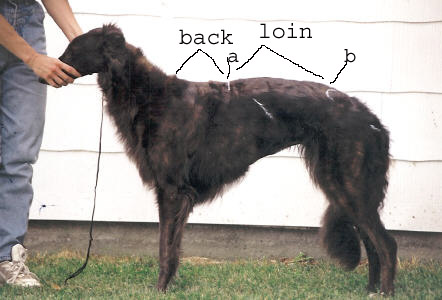
a- anticlinal vertebra, thoracic vertebra 11 (T11)
b- iliac crest
c- first thoracic vertebra (T1)
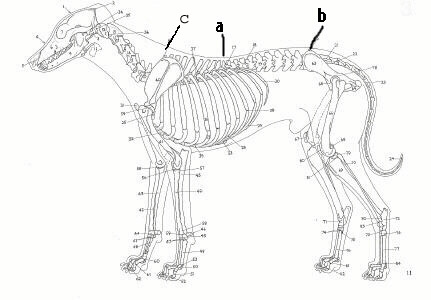
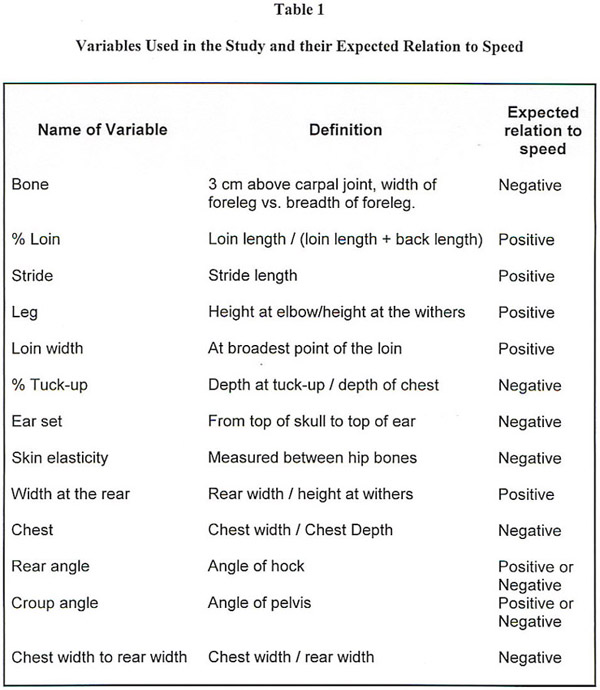
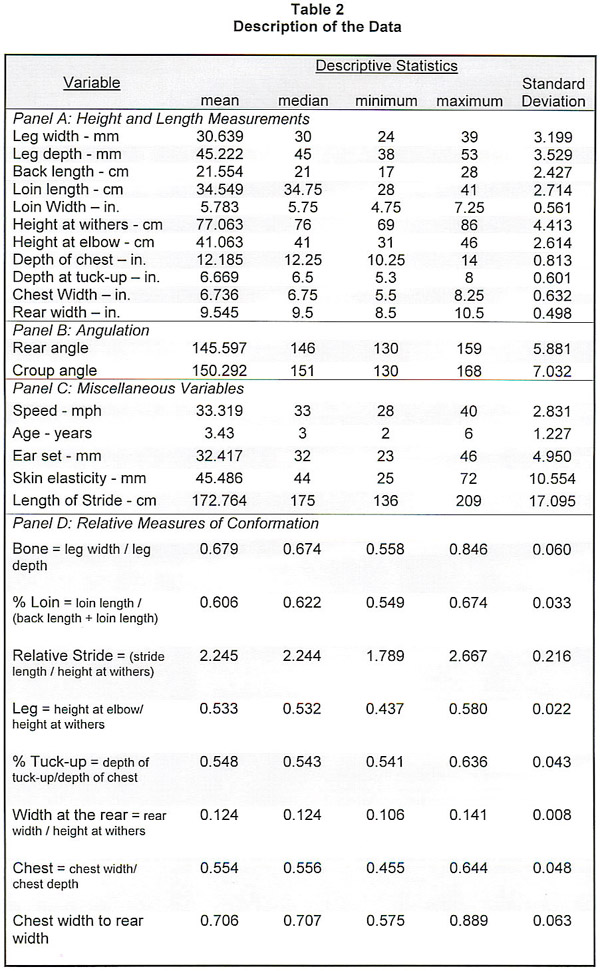
IV. Tests of the relation between Conformation and Speed
A) Test for differences in the mean and median conformation characteristics for the slower vs. faster Borzoi. The average (mean) speed in this study was 33 mph. The sample was divided into two groups, one is slower than 33mph and one is faster than this speed.
A p-value less than .05 indicates a significant difference in the mean or median. The lower the p-value, the less the chance that the difference in means or medians is due to random chance.
The faster group of borzoi in this study have significantly more bladed bone, longer loin to back, longer stride at a trot, higher ear set, tighter skin, wider rears, and less rear angulation than the slower group.
B) Test to determine characteristics that are linearly related to speed.
A p-value less than .05 indicates a significant linear relation to speed for that variable. If the variable’s sign is negative (positive), there is a negative (positive) relation between higher values of that variable and speed.
Note: Some characteristics may be related to speed – but not in a linear fashion. I.e., There may be some “optimal” hock angle – less than the maximum observed but more than the minimum observed.
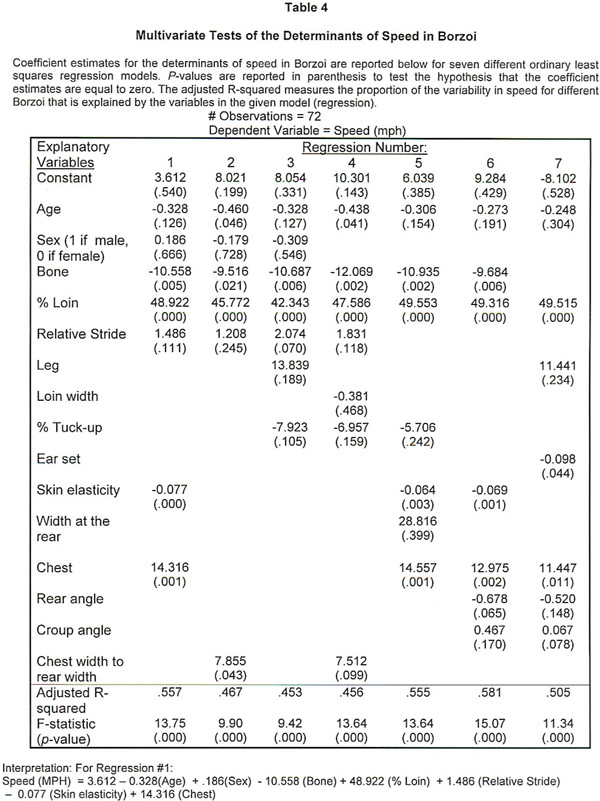
V) Conclusions:
1) short back to long loin
, bladed bone, tight elastic skin, high set ears, and a moderately broad deep chest are significant, positively related to speed. Combined together these factors explain approximately 58% of the differences in speed observed in these borzoi.2) The other conformational features studied are either not different enough within the population studied to affect speed, or their contribution to speed is minimal.
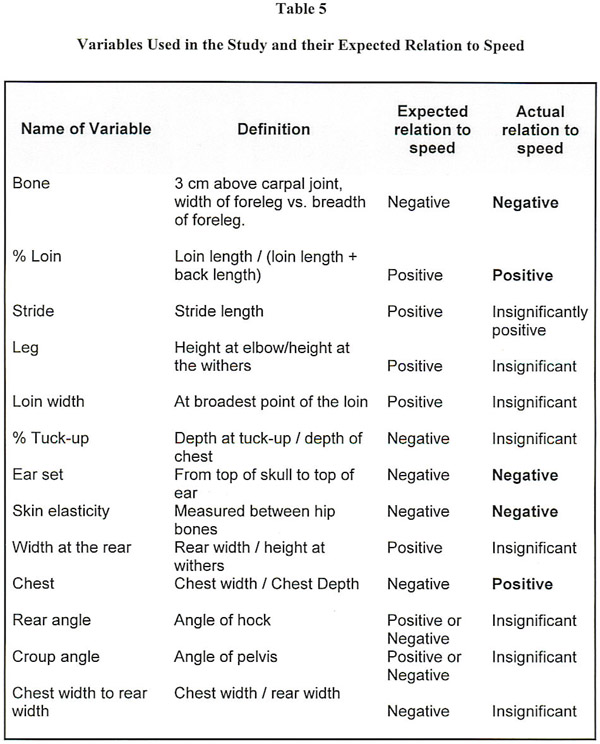
VI) Discussion:
A short back and ribs, with a comparatively long loin accounts for approximately 25% of a borzoi's speed. Another way of saying this is that the beginning of the rise over the loin (and thus it's highest point) should be noticeably far forward on the topline. In the fastest dogs the loin length is approximately twice the length of the back.
Bladed bone accounts for approximately 10% of a borzoi's speed. The legs should be very distinctly narrower when viewed from the front as compared to the side. In the fastest dogs, the foreleg is half to three quarters again deeper than it is wide.
High set ears and tight elastic skin are separate measures of connective tissue. Although the skin and ears themselves probably play a minimal role in speed, they are composed of the same connective tissues present in the joints, ligaments and tendons which play a huge role in a galloping hound. Tighter connective tissue creates a faster hound. High set ears and tight elastic skin each represent about 8% of a borzoi's speed.
A moderately broad to deep chest contributes approximately 5% to a borzoi's speed. Having a very narrow chest (slab sided) decreases speed even over short distances.
These 5 items are the areas, we as borzoi breeders need to preserve and reward in our show and breeding borzoi.
VII) Extensions or Refinements
1) Tests are needed on larger samples of Borzoi. Larger samples are needed to determine “optimal” measurements of conformation as they relate to speed.
2) Please contribute any ideas or information on how to refine this study to be as meaningful as possible.
Anne Midgarden, D.V.M.
12014 Bay Road
Wapakoneta, OH 45895